Prediction of Bending Properties for 3D-Printed Carbon Fibre/Epoxy Composites with Several Processing Parameters Using ANN and Statistical Methods
Abstract
:1. Introduction
2. Additive Manufacturing Processing Parameters
3. Materials and Methods
3.1. Experimental Details
3.2. Statistical Approach
3.3. Artificial Neural Network (ANN) Methodology
3.4. Response Surface Methodology (RSM)
4. Results and Discussion
4.1. Analysis of Variance (ANOVA) Results
4.2. ANN Prediction Data
4.3. Response Surface Methodology (SRM)
5. Conclusions
Supplementary Materials
Author Contributions
Funding
Institutional Review Board Statement
Informed Consent Statement
Data Availability Statement
Acknowledgments
Conflicts of Interest
References
- Uhlig, K.; Bittrich, L.; Spickenheuer, A.; Almeida, J.H.S. Waviness and fiber volume content analysis in continuous carbon fiber reinforced plastics made by tailored fiber placement. Compos. Struct. 2019, 222, 110910. [Google Scholar] [CrossRef]
- Castro, S.G.; Almeida, J.H.S., Jr.; St-Pierre, L.; Wang, Z. Measuring geometric imperfections of variable–angle filament–wound cylinders with a simple digital image correlation setup. Compos. Struct. 2021, 276, 114497. [Google Scholar] [CrossRef]
- Kim, B.-J.; Kim, J.; Cha, S.-H.; Shim, Y.-B.; Jeong, C.; Kim, N.; Park, Y.-B. Interfacial Enhancements between a Three-Dimensionally Printed Honeycomb-Truss Core and Woven Carbon Fiber/Polyamide-6 Facesheets in Sandwich-Structured Composites. Compos. Part A Appl. Sci. Manuf. 2021, 149, 106534. [Google Scholar] [CrossRef]
- Ornaghi, H.L.; Almeida, J.H.S.; Monticeli, F.M.; Neves, R.M.; Cioffi, M.O.H. Time-temperature behavior of carbon/epoxy laminates under creep loading. Mech. Time-Depend. Mater. 2020, 25, 601–615. [Google Scholar] [CrossRef]
- Goh, G.D.; Agarwala, S.; Goh, G.L.; Dikshit, V.; Sing, S.L.; Yeong, W.Y. Additive manufacturing in unmanned aerial vehicles (UAVs): Challenges and potential. Aerosp. Sci. Technol. 2017, 63, 140–151. [Google Scholar] [CrossRef]
- Ming, Y.; Zhang, S.; Han, W.; Wang, B.; Duan, Y.; Xiao, H. Investigation on process parameters of 3D printed continuous carbon fiber-reinforced thermosetting epoxy composites. Addit. Manuf. 2020, 33, 101184. [Google Scholar] [CrossRef]
- Azarov, A.V.; Antonov, F.K.; Golubev, M.V.; Khaziev, A.R.; Ushanov, S.A. Composite 3D printing for the small size unmanned aerial vehicle structure. Compos. Part B Eng. 2019, 169, 157–163. [Google Scholar] [CrossRef]
- Sano, Y.; Matsuzaki, R.; Ueda, M.; Todoroki, A.; Hirano, Y. 3D printing of discontinuous and continuous fibre composites using stereolithography. Addit. Manuf. 2018, 24, 521–527. [Google Scholar] [CrossRef]
- Shi, B.; Shang, Y.; Zhang, P.; Cuadros, A.P.; Qu, J.; Sun, B.; Gu, B.; Chou, T.-W.; Fu, K. Dynamic Capillary-Driven Additive Manufacturing of Continuous Carbon Fiber Composite. Matter 2020, 2, 1594–1604. [Google Scholar] [CrossRef]
- Gnanasekaran, K.; Heijmans, T.; van Bennekom, S.; Woldhuis, H.; Wijnia, S.; de With, G.; Friedrich, H. 3D printing of CNT- and graphene-based conductive polymer nanocomposites by fused deposition modeling. Appl. Mater. Today 2017, 9, 21–28. [Google Scholar] [CrossRef]
- Jiang, Z.; Diggle, B.; Tan, M.L.; Viktorova, J.; Bennett, C.W.; Connal, L.A. Extrusion 3D Printing of Polymeric Materials with Advanced Properties. Adv. Sci. 2020, 7. [Google Scholar] [CrossRef] [PubMed]
- Azarov, A.V.; Antonov, F.K.; Vasil’Ev, V.V.; Golubev, M.V.; Krasovskii, D.S.; Razin, A.F.; Salov, V.A.; Stupnikov, V.V.; Khaziev, A. Development of a two-matrix composite material fabricated by 3D printing. Polym. Sci. Ser. D 2017, 10, 87–90. [Google Scholar] [CrossRef]
- Raney, J.R.; Compton, B.G.; Mueller, J.; Ober, T.J.; Shea, K.; Lewis, J.A. Rotational 3D printing of damage-tolerant composites with programmable mechanics. Proc. Natl. Acad. Sci. USA 2018, 115, 1198–1203. [Google Scholar] [CrossRef] [PubMed]
- Marton, A.M.; Monticeli, F.M.; Zanini, N.C.; Barbosa, R.F.; Medeiros, S.F.; Rosa, D.S.; Mulinari, D.R. Revalorization of Australian royal palm (Archontophoenix alexandrae) waste as reinforcement in acrylonitrile butadiene styrene (ABS) for use in 3D printing pen. J. Clean. Prod. 2022, 365. [Google Scholar] [CrossRef]
- Ahmadifar, M.; Benfriha, K.; Shirinbayan, M.; Tcharkhtchi, A. Additive Manufacturing of Polymer-Based Composites Using Fused Filament Fabrication (FFF): A Review. Appl. Compos. Mater. 2021, 28, 1335–1380. [Google Scholar] [CrossRef]
- Wu, Y.; Wang, K.; Neto, V.; Peng, Y.; Valente, R.; Ahzi, S. Interfacial behaviors of continuous carbon fiber reinforced polymers manufactured by fused filament fabrication: A review and prospect. Int. J. Mater. Form. 2022, 15, 1–18. [Google Scholar] [CrossRef]
- Sanei, S.H.R.; Popescu, D. 3D-Printed Carbon Fiber Reinforced Polymer Composites: A Systematic Review. J. Compos. Sci. 2020, 4, 98. [Google Scholar] [CrossRef]
- Monticeli, F.M.; Neves, R.M.; Jr, H.L.O.; Jr, J.H.S.A. A systematic review on high-performance fiber-reinforced 3D printed thermoset composites. Polym. Compos. 2021, 42, 3702–3715. [Google Scholar] [CrossRef]
- Ming, Y.; Duan, Y.; Wang, B.; Xiao, H.; Zhang, X. A Novel Route to Fabricate High-Performance 3D Printed Continuous Fiber-Reinforced Thermosetting Polymer Composites. Materials 2019, 12, 1369. [Google Scholar] [CrossRef]
- Nawafleh, N.; Elibol, F.K.E.; Aljaghtham, M.; Oflaz, E.; Ciciriello, A.J.; Dumont, C.M.; Dauer, E.; Gorguluarslan, R.M.; Demir, T.; Celik, E. Static and dynamic mechanical performance of short Kevlar fiber reinforced composites fabricated via direct ink writing. J. Mater. Sci. 2020, 55, 11284–11295. [Google Scholar] [CrossRef]
- Parandoush, P.; Lin, D. A review on additive manufacturing of polymer-fiber composites. Compos. Struct. 2017, 182, 36–53. [Google Scholar] [CrossRef]
- van de Werken, N.; Tekinalp, H.; Khanbolouki, P.; Ozcan, S.; Williams, A.; Tehrani, M. Additively manufactured carbon fiber-reinforced composites: State of the art and perspective. Addit. Manuf. 2019, 31, 100962. [Google Scholar] [CrossRef]
- Griffini, G.; Invernizzi, M.; Levi, M.; Natale, G.; Postiglione, G.; Turri, S. 3D-printable CFR polymer composites with dual-cure sequential IPNs. Polymer 2016, 91, 174–179. [Google Scholar] [CrossRef]
- Pierson, H.A.; Celik, E.; Abbott, A.; De Jarnette, H.; Gutierrez, L.S.; Johnson, K.; Koerner, H.; Baur, J.W. Mechanical Properties of Printed Epoxy-Carbon Fiber Composites. Exp. Mech. 2019, 59, 843–857. [Google Scholar] [CrossRef]
- Kuncius, T.; Rimašauskas, M.; Rimašauskienė, R. Interlayer Adhesion Analysis of 3D-Printed Continuous Carbon Fibre-Reinforced Composites. Polymers 2021, 13, 1653. [Google Scholar] [CrossRef] [PubMed]
- Maqsood, N.; Rimašauskas, M. Delamination observation occurred during the flexural bending in additively manufactured PLA-short carbon fiber filament reinforced with continuous carbon fiber composite. Results Eng. 2021, 11, 100246. [Google Scholar] [CrossRef]
- Zhang, H.; Chen, J.; Yang, D. Fibre misalignment and breakage in 3D printing of continuous carbon fibre reinforced thermoplastic composites. Addit. Manuf. 2020, 38, 101775. [Google Scholar] [CrossRef]
- van de Werken, N.; Hurley, J.; Khanbolouki, P.; Sarvestani, A.N.; Tamijani, A.Y.; Tehrani, M. Design considerations and modeling of fiber reinforced 3D printed parts. Compos. Part B Eng. 2018, 160, 684–692. [Google Scholar] [CrossRef]
- Bhandari, S.; Lopez-Anido, R.A.; Wang, L.; Gardner, D.J. Elasto-Plastic Finite Element Modeling of Short Carbon Fiber Reinforced 3D Printed Acrylonitrile Butadiene Styrene Composites. JOM 2019, 72, 475–484. [Google Scholar] [CrossRef]
- Hu, C.; Dong, J.; Luo, J.; Qin, Q.-H.; Sun, G. 3D printing of chiral carbon fiber reinforced polylactic acid composites with negative Poisson’s ratios. Compos. Part B Eng. 2020, 201, 108400. [Google Scholar] [CrossRef]
- Bodaghi, M.; Damanpack, A.R.; Liao, W.H. Self-expanding/shrinking structures by 4D printing. Smart Mater. Struct. 2016, 25, 105034. [Google Scholar] [CrossRef]
- Zhang, H.; Yang, D.; Sheng, Y. Performance-driven 3D printing of continuous curved carbon fibre reinforced polymer composites: A preliminary numerical study. Compos. Part B Eng. 2018, 151, 256–264. [Google Scholar] [CrossRef]
- Moradi, M.; Moghadam, M.K.; Shamsborhan, M.; Bodaghi, M. The Synergic Effects of FDM 3D Printing Parameters on Mechanical Behaviors of Bronze Poly Lactic Acid Composites. J. Compos. Sci. 2020, 4, 17. [Google Scholar] [CrossRef]
- Meiabadi, M.S.; Moradi, M.; Karamimoghadam, M.; Ardabili, S.; Bodaghi, M.; Shokri, M.; Mosavi, A.H. Modeling the Producibility of 3D Printing in Polylactic Acid Using Artificial Neural Networks and Fused Filament Fabrication. Polymers 2021, 13, 3219. [Google Scholar] [CrossRef]
- LeCun, Y.; Bengio, Y.; Hinton, G. Deep learning. Nature 2015, 521, 436–444. [Google Scholar] [CrossRef]
- Fotouhi, S.; Pashmforoush, F.; Bodaghi, M.; Fotouhi, M. Autonomous damage recognition in visual inspection of laminated composite structures using deep learning. Compos. Struct. 2021, 268, 113960. [Google Scholar] [CrossRef]
- Shinde, P.P.; Shah, S. A Review of Machine Learning and Deep Learning Applications. In Proceedings of the 2018 Fourth International Conference on Computing Communication Control and Automation (ICCUBEA), Pune, India, 16–18 August 2018; 2018; pp. 1–6. [Google Scholar] [CrossRef]
- Han, B. Application of Deep Learning in Medical Imaging. In Proceedings of the 2021 2nd International Conference on Computing and Data Science (CDS), Stanford, CA, USA, 28–29 January 2021; 2021; pp. 49–56. [Google Scholar] [CrossRef]
- Tavanaei, A.; Ghodrati, M.; Kheradpisheh, S.R.; Masquelier, T.; Maida, A. Deep learning in spiking neural networks. Neural Networks 2018, 111, 47–63. [Google Scholar] [CrossRef]
- Yadav, D.; Chhabra, D.; Garg, R.K.; Ahlawat, A.; Phogat, A. Optimization of FDM 3D printing process parameters for multi-material using artificial neural network. Mater. Today Proc. 2019, 21, 1583–1591. [Google Scholar] [CrossRef]
- Nagarajan, H.P.N.; Mokhtarian, H.; Jafarian, H.; Dimassi, S.; Bakrani-Balani, S.; Hamedi, A.; Coatanéa, E.; Wang, G.G.; Haapala, K.R. Knowledge-Based Design of Artificial Neural Network Topology for Additive Manufacturing Process Modeling: A New Approach and Case Study for Fused Deposition Modeling. J. Mech. Des. 2018, 141. [Google Scholar] [CrossRef]
- Ciotti, M.; Campana, G.; Mele, M. A review of the accuracy of thermoplastic polymeric parts fabricated by additive manufacturing. Rapid. Prototyp J. 2021, 2, 358–389. [Google Scholar] [CrossRef]
- Türk, D.-A.; Kussmaul, R.; Zogg, M.; Klahn, C.; Leutenecker-Twelsiek, B.; Meboldt, M. Composites Part Production with Additive Manufacturing Technologies. Procedia CIRP 2017, 66, 306–311. [Google Scholar] [CrossRef]
- Rimašauskas, M.; Jasiūnienė, E.; Kuncius, T.; Rimašauskienė, R.; Cicėnas, V. Investigation of influence of printing parameters on the quality of 3D printed composite structures. Compos. Struct. 2021, 281, 115061. [Google Scholar] [CrossRef]
- Palanikumar, K.; Mudhukrishnan, M.; Soorya Prabha, P. Technologies in additive manufacturing for fiber reinforced composite materials: A review. Curr. Opin. Chem. Eng. 2020, 28, 51–59. [Google Scholar] [CrossRef]
- Abbott, A.; Gibson, T.; Tandon, G.; Hu, L.; Avakian, R.; Baur, J.; Koerner, H. Melt extrusion and additive manufacturing of a thermosetting polyimide. Addit. Manuf. 2020, 37, 101636. [Google Scholar] [CrossRef]
- Kedari, V.R.; Farah, B.I.; Hsiao, K.-T. Effects of vacuum pressure, inlet pressure, and mold temperature on the void content, volume fraction of polyester/e-glass fiber composites manufactured with VARTM process. J. Compos. Mater. 2011, 45, 2727–2742. [Google Scholar] [CrossRef]
- Xiao, H.; Han, W.; Ming, Y.; Ding, Z.; Duan, Y. A Sensitivity Analysis-Based Parameter Optimization Framework for 3D Printing of Continuous Carbon Fiber/Epoxy Composites. Materials 2019, 12, 3961. [Google Scholar] [CrossRef]
- MONT. In Catalysis from A to Z: A Concise Encyclopedia; Wiley-VCH Verlag GmbH & Co. KGaA: Weinheim, Germany, 2020. [CrossRef]
- Fernández-Fdz, D.; López-Puente, J.; Zaera, R. Prediction of the behaviour of CFRPs against high-velocity impact of solids employing an artificial neural network methodology. Compos. Part A Appl. Sci. Manuf. 2008, 39, 989–996. [Google Scholar] [CrossRef]
- Lingaraju, D.; Ramji, K.; Rao, N.M.; Lakshmi, U.R. Characterization and prediction of some engineering properties of polymer—Clay/Silica hybrid nanocomposites through ANN and regression models. Procedia Eng. 2011, 10, 9–18. [Google Scholar] [CrossRef]
- Zhang, Z.; Klein, P.; Friedrich, K. Dynamic mechanical properties of PTFE based short carbon fibre reinforced composites: Experiment and artificial neural network prediction. Compos. Sci. Technol. 2002, 62, 1001–1009. [Google Scholar] [CrossRef]
- El Kadi, H. Modeling the mechanical behavior of fiber-reinforced polymeric composite materials using artificial neural networks—A review. Compos. Struct. 2006, 73, 1–23. [Google Scholar] [CrossRef]
- Paneiro, G.; Durão, F.; e Silva, M.M.H.C.; Neves, P.F. Artificial neural network model for ground vibration amplitudes prediction due to light railway traffic in urban areas. Neural Comput. Appl. 2016, 29, 1045–1057. [Google Scholar] [CrossRef]
- Fausett, L. Fundamentals of Neural Networks: Architectures, Algorithms and Applications, 1st ed.; Pearson: London, UK, 1994. [Google Scholar]
- Koushyar, H.; Alavi-Soltani, S.; Minaie, B.; Violette, M. Effects of variation in autoclave pressure, temperature, and vacuum-application time on porosity and mechanical properties of a carbon fiber/epoxy composite. J. Compos. Mater. 2011, 46, 1985–2004. [Google Scholar] [CrossRef]
- Verma, N.; Kumar, R.; Zafar, S.; Pathak, H. Vacuum-assisted microwave curing of epoxy/carbon fiber composite: An attempt for defect reduction in processing. Manuf. Lett. 2020, 24, 127–131. [Google Scholar] [CrossRef]
- Ma, Y.; Wang, J.; Zhao, Y.; Wei, X.; Ju, L.; Chen, Y. A New Vacuum Pressure Infiltration CFRP Method and Preparation Experimental Study of Composite. Polymers 2020, 12, 419. [Google Scholar] [CrossRef]
- Zweifel, L.; Brunner, J.; Nakouzi-Queloz, S.; Brauner, C.; Dransfeld, C. Development of a resistance welding process for thermoset fiber composite components with co-cured thermoplastic boundary layer. In Proceedings of the ECCM 2018—18th Eur Conf Compos Mater 2020, Athens, Greece, 25–28 June 2018. [Google Scholar]
- Abali, B.E.; Vorel, J.; Wan-Wendner, R. Thermo-mechano-chemical modeling and computation of thermosetting polymers used in post-installed fastening systems in concrete structures. Contin. Mech. Thermodyn. 2020, 1–19. [Google Scholar] [CrossRef]
- Prasatya, P.; McKenna, G.B.; Simon, S.L. A Viscoelastic Model for Predicting Isotropic Residual Stresses in Thermosetting Materials: Effects of Processing Parameters. J. Compos. Mater. 2001, 35, 826–848. [Google Scholar] [CrossRef]
- Monticeli, F.M.; Almeida, J.H.S., Jr.; Neves, R.M.; Ornaghi, F.G.; Ornaghi, H.L. On the 3D void formation of hybrid carbon/glass fiber composite laminates: A statistical approach. Compos. Part A: Appl. Sci. Manuf. 2020, 137, 106036. [Google Scholar] [CrossRef]
- Zębala, W.; Kowalczyk, R. Estimating the effect of cutting data on surface roughness and cutting force during WC-Co turning with PCD tool using Taguchi design and ANOVA analysis. Int. J. Adv. Manuf. Technol. 2014, 77, 2241–2256. [Google Scholar] [CrossRef]


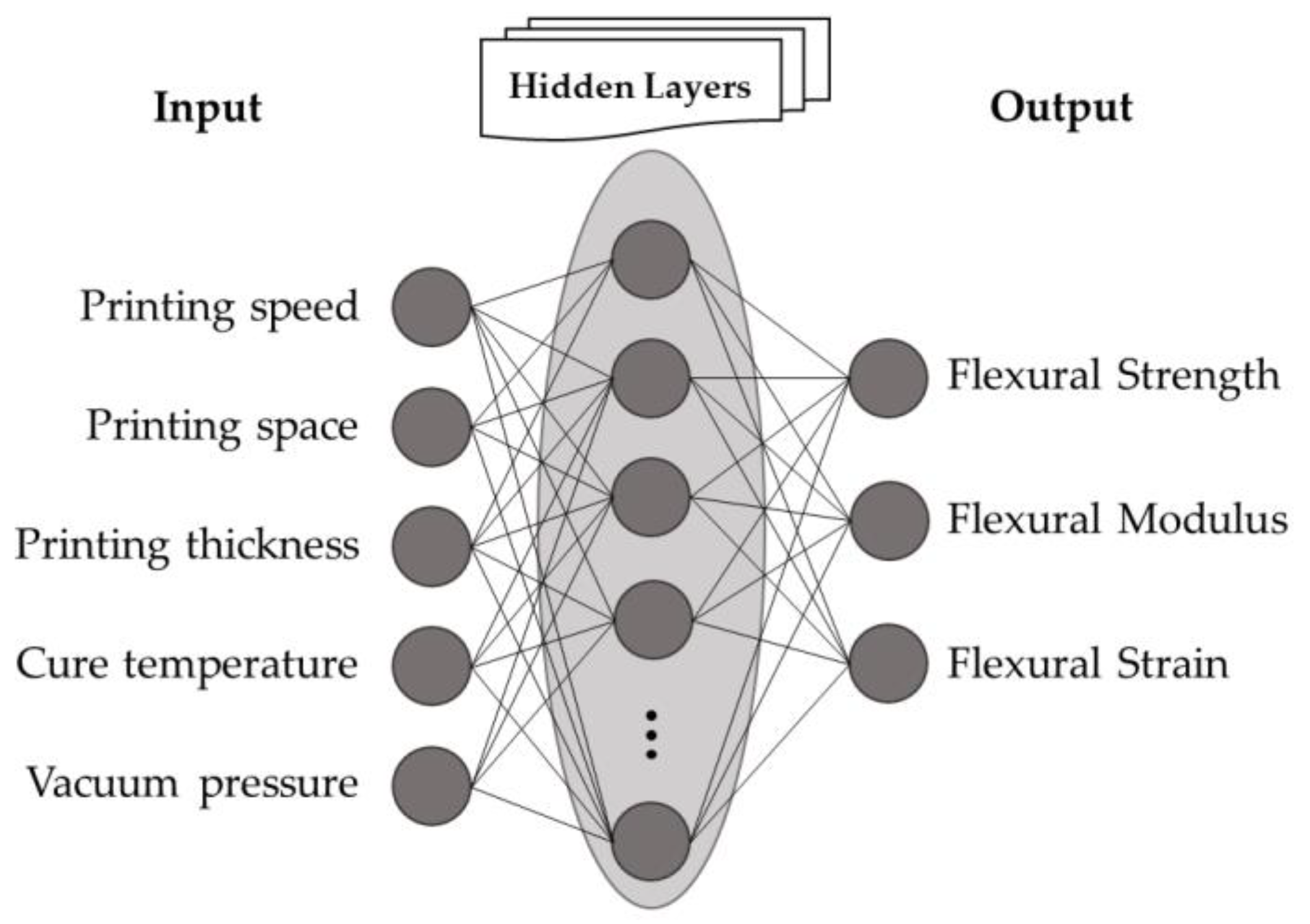
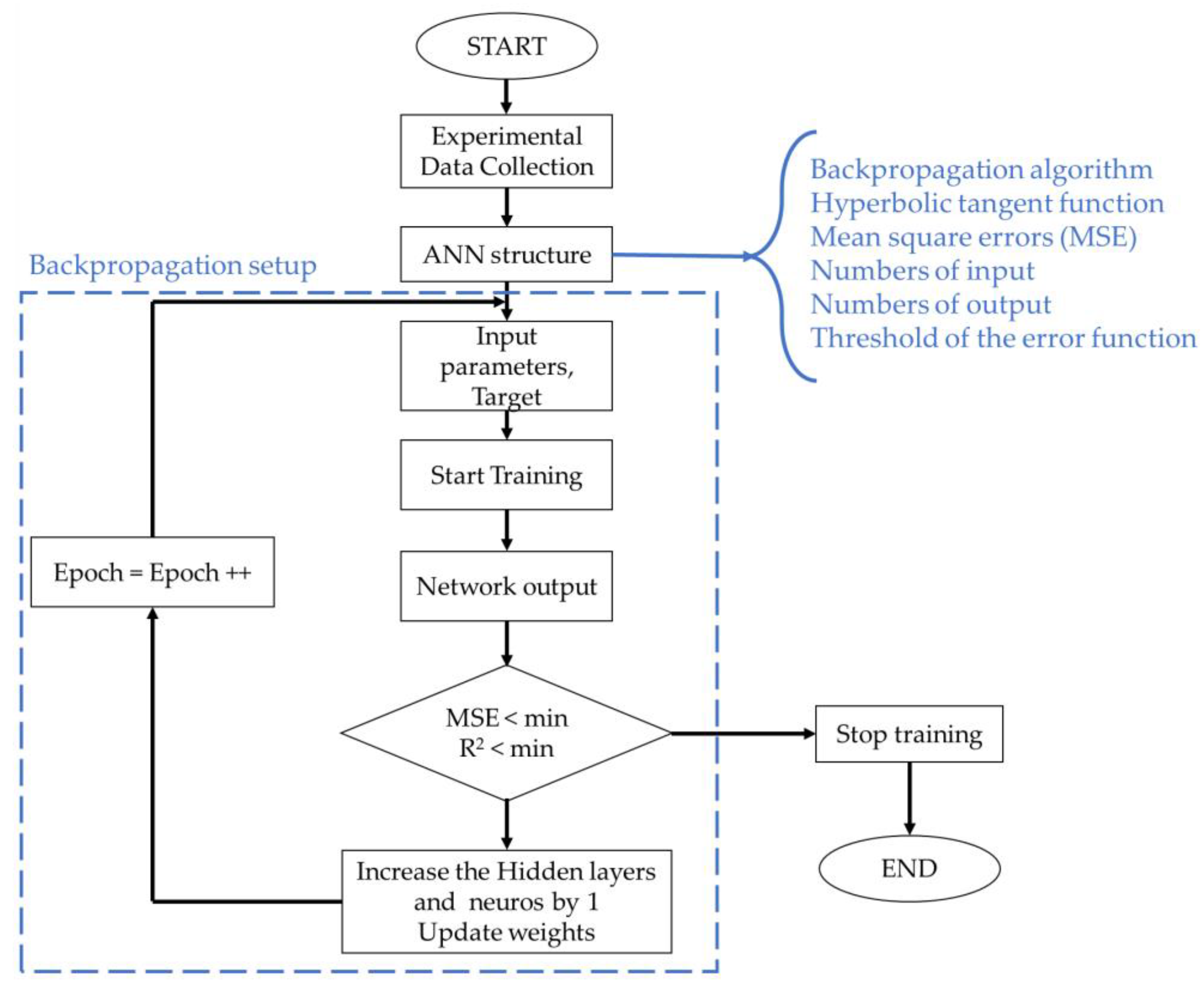


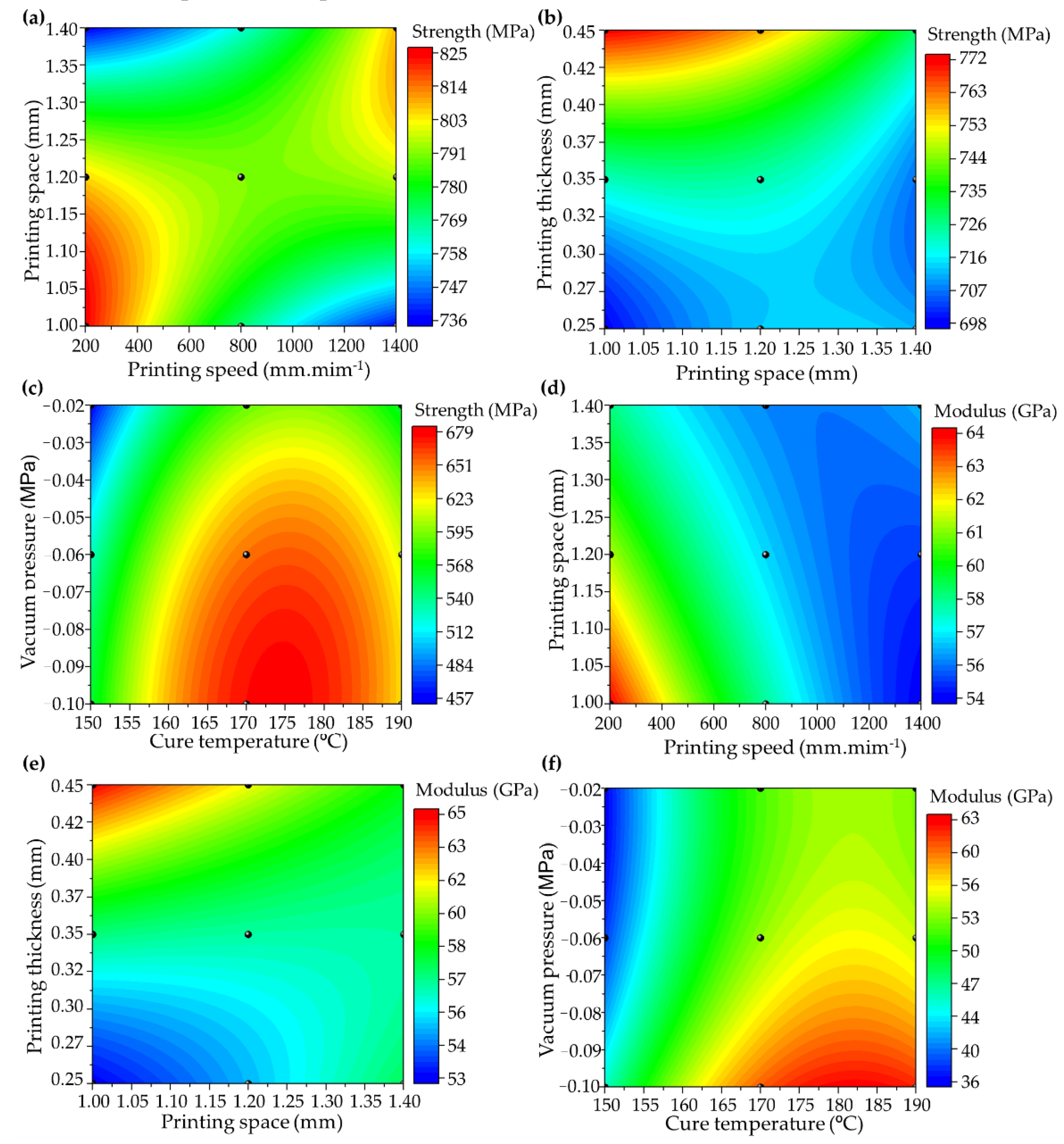
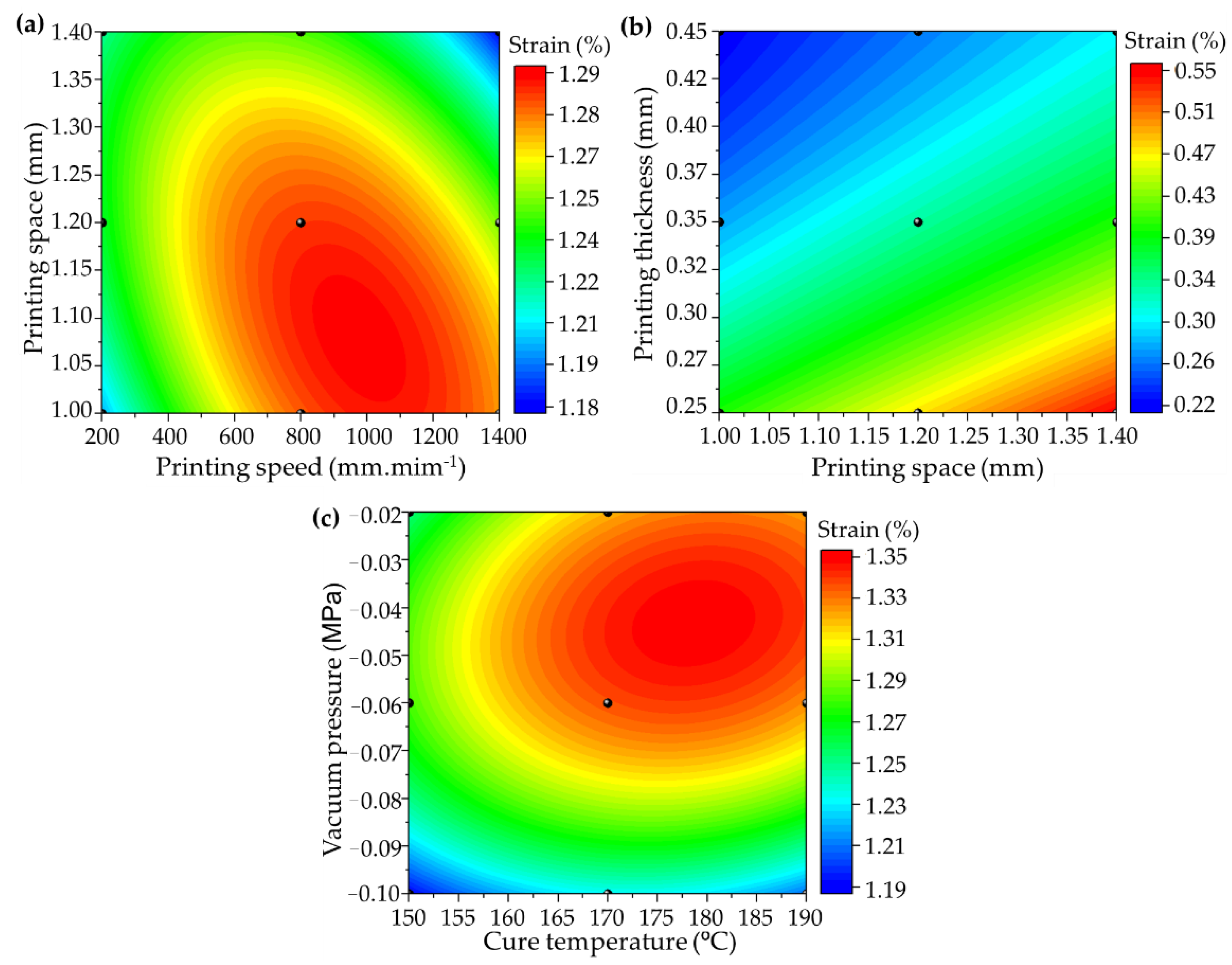
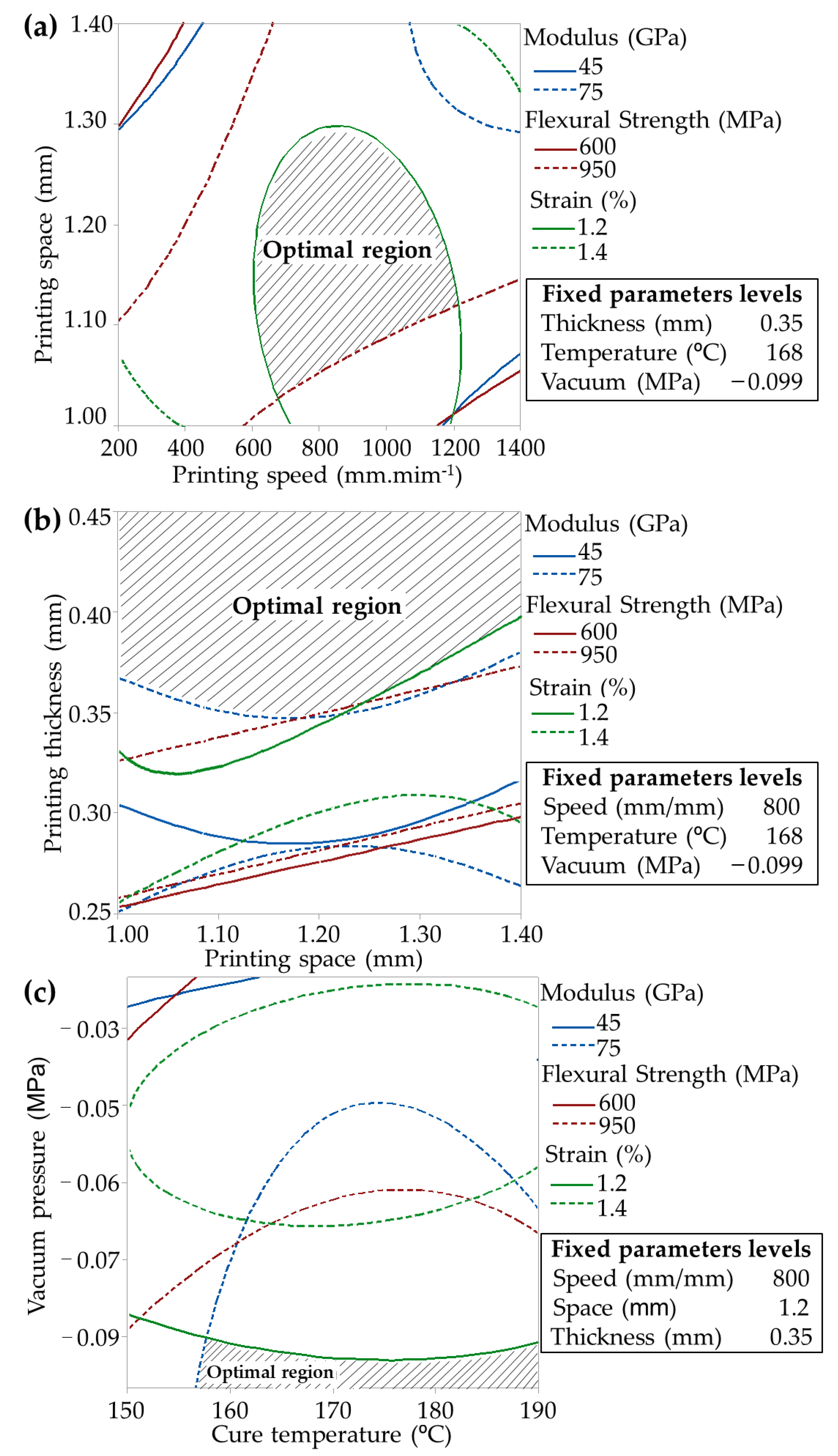
| Exp. No | Speed (mm·min−1) | Spacing (mm) | Thickness (mm) | Curing Temperature (°C) | Vacuum Pressure (MPa) |
|---|---|---|---|---|---|
| 1 | 200 | 1.40 | 0.45 | 190 | −0.10 |
| 2 | 500 | 1.20 | 0.30 | 180 | −0.10 |
| 3 | 800 | 1.00 | 0.40 | 170 | −0.10 |
| 4 | 1100 | 1.30 | 0.25 | 160 | −0.10 |
| 5 | 1400 | 1.10 | 0.35 | 150 | −0.10 |
| 6 | 200 | 1.30 | 0.40 | 180 | −0.08 |
| 7 | 500 | 1.10 | 0.25 | 170 | −0.08 |
| 8 | 800 | 1.40 | 0.35 | 160 | −0.08 |
| 9 | 1100 | 1.20 | 0.45 | 150 | −0.08 |
| 10 | 1400 | 1.00 | 0.30 | 190 | −0.08 |
| 11 | 200 | 1.20 | 0.35 | 170 | −0.06 |
| 12 | 500 | 1.00 | 0.45 | 160 | −0.06 |
| 13 | 800 | 1.30 | 0.30 | 150 | −0.06 |
| 14 | 1100 | 1.10 | 0.40 | 190 | −0.06 |
| 15 | 1400 | 1.40 | 0.25 | 180 | −0.06 |
| 16 | 200 | 1.10 | 0.30 | 160 | −0.04 |
| 17 | 500 | 1.40 | 0.40 | 150 | −0.04 |
| 18 | 800 | 1.20 | 0.25 | 190 | −0.04 |
| 19 | 1100 | 1.00 | 0.35 | 180 | −0.04 |
| 20 | 1400 | 1.30 | 0.45 | 170 | −0.04 |
| 21 | 200 | 1.00 | 0.25 | 150 | −0.02 |
| 22 | 500 | 1.30 | 0.35 | 190 | −0.02 |
| 23 | 800 | 1.10 | 0.45 | 180 | −0.02 |
| 24 | 1100 | 1.40 | 0.30 | 170 | −0.02 |
| 25 | 1400 | 1.20 | 0.40 | 160 | −0.02 |
| Flexural Strength | F | p-Value | Fcritical |
|---|---|---|---|
| Speed | 15.95 | × 10−2 | 3.95 |
| Space | 43.99 | × 10−78 | 3.95 |
| Thickness | 44.09 | × 10−78 | 3.95 |
| Cure temperature | 25.67 | × 10−68 | 3.95 |
| Vacuum pressure | 44.15 | × 10−78 | 3.95 |
| Flexural Modulus | F | p-Value | Fcritical |
| Speed | 21.13 | × 10−25 | 3.95 |
| Space | 312.13 | × 10−71 | 3.95 |
| Thickness | 321.74 | × 10−78 | 3.95 |
| Cure temperature | 188.92 | × 10−62 | 3.95 |
| Vacuum pressure | 326.56 | × 10−72 | 3.95 |
| Flexural Strain | F | p-Value | Fcritical |
| Speed | 24.45 | × 10−27 | 3.95 |
| Space | 5.75 | × 10−05 | 3.95 |
| Thickness | 416.94 | × 10−77 | 3.95 |
| Cure temperature | 532.34 | × 10−82 | 3.95 |
| Vacuum pressure | 117.45 | × 10−97 | 3.95 |
| No | Experimental Data | ANN Prediction Data | Average Error (%) | ||||
|---|---|---|---|---|---|---|---|
| Flexural Strength (MPa) | Flexural Modulus (GPa) | Strain (%) | Flexural Strength (MPa) | Flexural Modulus (GPa) | Strain (%) | ||
| 1 | 666.36 | 54.95 | 1.21 | 665.78 | 54.68 | 1.21 | 0.19 |
| 2 | 712.34 | 58.88 | 1.21 | 711.49 | 58.81 | 1.21 | 0.18 |
| 3 | 697.50 | 57.58 | 1.21 | 697.02 | 57.65 | 1.21 | 0.14 |
| 4 | 682.40 | 51.45 | 1.33 | 682.51 | 51.80 | 1.32 | 0.37 |
| 5 | 702.97 | 53.38 | 1.32 | 704.14 | 53.59 | 1.32 | 0.22 |
| 6 | 767.16 | 58.66 | 1.31 | 770.24 | 59.15 | 1.31 | 0.48 |
| 7 | 861.60 | 71.63 | 1.20 | 846.60 | 70.06 | 1.20 | 1.39 |
| 8 | 792.85 | 63.66 | 1.25 | 791.94 | 63.46 | 1.25 | 0.21 |
| 9 | 817.12 | 66.34 | 1.23 | 806.71 | 66.08 | 1.23 | 0.60 |
| 10 | 721.16 | 57.85 | 1.25 | 721.23 | 57.89 | 1.24 | 0.15 |
| 11 | 801.94 | 65.47 | 1.22 | 796.80 | 65.41 | 1.22 | 0.29 |
| 12 | 842.47 | 67.38 | 1.25 | 837.55 | 67.10 | 1.25 | 0.34 |
| 13 | 636.22 | 48.66 | 1.31 | 636.32 | 48.37 | 1.30 | 0.27 |
| 14 | 783.97 | 60.80 | 1.29 | 780.15 | 60.62 | 1.29 | 0.30 |
| 15 | 778.96 | 63.74 | 1.22 | 779.13 | 63.28 | 1.23 | 0.44 |
| 16 | 717.46 | 61.36 | 1.17 | 718.89 | 61.55 | 1.17 | 0.23 |
| 17 | 740.25 | 57.64 | 1.28 | 740.73 | 57.83 | 1.29 | 0.21 |
| 18 | 616.99 | 44.32 | 1.39 | 618.43 | 44.45 | 1.37 | 0.60 |
| 19 | 679.31 | 50.83 | 1.34 | 680.58 | 50.80 | 1.36 | 0.61 |
| 20 | 745.86 | 52.94 | 1.41 | 769.05 | 53.63 | 1.39 | 1.90 |
| 21 | 660.87 | 57.51 | 1.15 | 660.69 | 57.60 | 1.15 | 0.07 |
| 22 | 696.00 | 65.82 | 1.06 | 693.32 | 65.41 | 1.06 | 0.39 |
| 23 | 674.68 | 53.15 | 1.27 | 676.85 | 53.00 | 1.27 | 0.23 |
| 24 | 636.58 | 48.90 | 1.30 | 637.13 | 48.93 | 1.30 | 0.14 |
| 25 | 707.05 | 53.70 | 1.32 | 696.22 | 53.44 | 1.32 | 0.68 |
| Parameters | Optimal Inputs | ||
|---|---|---|---|
| RSM | ANN | ||
| Speed (mm·min−1) | 800 | 796 | |
| Space (mm) | 1.20 | 1.20 | |
| Thickness (mm) | 0.35 | 0.35 | |
| Temperature (°C) | 168 | 166 | |
| Vacuum (MPa) | −0.099 | −0.096 | |
| Desirability | 0.90 | 0.93 | |
| RSM | Flexural Strength (MPa) | Modulus (GPa) | Strain (%) |
| Predicted values | 958.81 | 72.87 | 1.29 |
| Error | 0.62% | −1.28% | −2.57% |
| ANN | Flexural Strength (MPa) | Modulus (GPa) | Strain (%) |
| Predicted values | 954.15 | 71.52 | 1.34 |
| Error | 0.13% | −0.60% | 1.26% |
Publisher’s Note: MDPI stays neutral with regard to jurisdictional claims in published maps and institutional affiliations. |
© 2022 by the authors. Licensee MDPI, Basel, Switzerland. This article is an open access article distributed under the terms and conditions of the Creative Commons Attribution (CC BY) license (https://creativecommons.org/licenses/by/4.0/).
Share and Cite
Monticeli, F.M.; Neves, R.M.; Ornaghi, H.L.; Almeida, J.H.S. Prediction of Bending Properties for 3D-Printed Carbon Fibre/Epoxy Composites with Several Processing Parameters Using ANN and Statistical Methods. Polymers 2022, 14, 3668. https://doi.org/10.3390/polym14173668
Monticeli FM, Neves RM, Ornaghi HL, Almeida JHS. Prediction of Bending Properties for 3D-Printed Carbon Fibre/Epoxy Composites with Several Processing Parameters Using ANN and Statistical Methods. Polymers. 2022; 14(17):3668. https://doi.org/10.3390/polym14173668
Chicago/Turabian StyleMonticeli, Francisco M., Roberta M. Neves, Heitor L. Ornaghi, and José Humberto S. Almeida. 2022. "Prediction of Bending Properties for 3D-Printed Carbon Fibre/Epoxy Composites with Several Processing Parameters Using ANN and Statistical Methods" Polymers 14, no. 17: 3668. https://doi.org/10.3390/polym14173668






